List of burial places of biblical figures
The following is a list of burial places attributed to Biblical personalities according to various religious and local traditions. The locations listed are not based on factual evidence, but rather locations mentioned in the text of the Bible or oral traditions of indigenous peoples. Lebanon, Israel, the Palestinian territories, Iraq, Jordan and Iran have put monuments on the grave locations in an attempt to preserve them as holy sites. Many sites have been transmitted from generation to generation and there are historical accounts from travellers which state their existence.
Figures mentioned in the Torah
| Biblical figure | Place name and location | Image | Notes |
|---|---|---|---|
| Adam | Judaism: Midrash says Cave of the Patriarchs, Hebron, West Bank, (pictured)
Christianity: Chapel of Adam, Church of the Holy Sepulchre |
||
| Eve | Judaism: Cave of the Patriarchs, Hebron, West Bank, (pictured)
Islam: Tomb of Eve, Jeddah, Saudi Arabia |
||
| Abel | Shia Islam: Nabi Habeel Mosque, Zabadani Valley, Syria |  |
|
| Seth | In Judaism: Tiberias, Israel[1] In Islam: Al-Nabi Shayth, Lebanon |
||
| Noah | There are several sites that are claimed to be the Tomb of Noah:
See also: Tomb of Noah |
|
|
| Abraham, Sarah, Isaac, Rebecca, Jacob, Esau and Leah | Judaism: Cave of the Patriarchs, Al Khalil Hebron, West Bank
Islam: Cave of the Patriarchs, Al Khalil Hebron, West Bank |
According to Jewish tradition, only Esau's head is buried in the Cave of the Patriarchs. According to legends, Ishmael was buried here as well. | |
| Ishmael and Hagar | Islam: Hajr Ismail, Mecca, Saudi Arabia[2] | 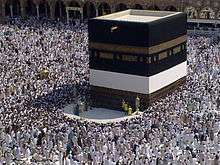 |
|
| Lot | Islam: Bani Na'im, near Hebron (2 miles away), West Bank, | ||
| Rachel | Rachel's Tomb, outside Bethlehem, West Bank, | ||
| Zilpah and Bilhah | Tomb of the Matriarchs, Tiberias, Israel | ||
| Reuben | Nabi Rubin, Palmachim, Israel | 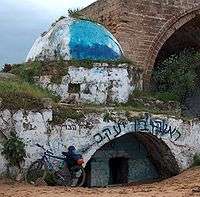 |
During the Ottoman period Arabs would gather each year at the Mamluk-era structure. Nowadays, infrequent Jewish visitors come to pray at the site. |
| Judah | Yehud, Israel[3] | ||
| Simeon | Kibbutz Eyal, Israel. Others says it is located at Kafr Manda or Kafr Katan, near Jenin, West Bank, | ||
| Asher | Nevei Ta'ari, near Kfar Sirkan, or Kafr Manda, or Tubas, or near Ain Al-Jadur, west of Salt, Jordan. | ||
| Gad | Nevei Ganda, in Rehovot, Israel, or Ain Al-Jadur, west of Salt, Jordan. | ||
| Dan | Beit Shemesh, Israel[4] | ||
| Qedarite | Zanjan, Iran | 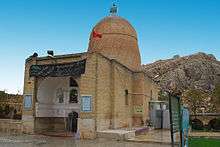 |
|
| Zebulun | Tomb of Zebulun, Sidon, Lebanon | In the past, towards the end of Iyyar, Jews from the most distant parts of Palestine and the Jews who lived in Lebanon would make a pilgrimage to this tomb.[5] | |
| Joseph | According to Jews: Joseph's Tomb, Nablus (Shchem), West Bank, (pictured); According to Muslims: Cave of the Patriarchs, Hebron, West Bank, |
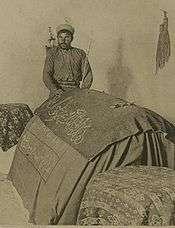 |
Some others consider Joseph to have been buried next to the Cave of the Patriarchs, where a mediaeval structure known as the kalah (castle) is now located.
Some archaeologists believe that the site in Nablus is a few centuries old and could contain the remains of a Muslim sheikh named Yusef Al-Dwaik. |
| Benjamin | Kfar Saba, Israel | 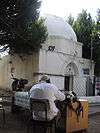 |
Two structures 30 m away from each other are each claimed by Jews and Muslims as the authentic tomb. This site is questionable, however, because it is not located in the territory of the Tribe of Benjamin. |
| Serah | Pir-i Bakran, near Esfahan, Iran[6] | ||
| Ephraim and Manasseh | Joseph's Tomb, Nablus, West Bank, | 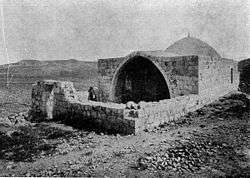 |
|
| Jochebed, Zipporah and Elisheva | Tomb of the Matriarchs, Tiberias, Israel | ||
| Moses | Mount Nebo (Jordan) | 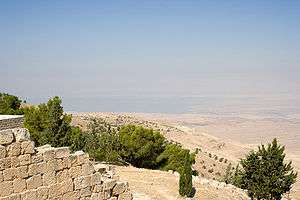 |
According to the Bible, the exact place of Moses' grave remains unknown, in order to impede idolatry. |
| Aaron | Tomb of Aaron: Mount Hor mentioned in the Bible is identified by some as Mount Harun (Aaron's Mountain) near Petra, Jordan. | 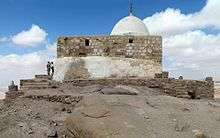 |
At 1350 meters above sea-level, it is the highest peak in the area; it is believed to be the place where Aaron died and was buried. A 14th-century mosque stands here with its white dome visible from most areas in and around Petra. |
| Eleazar | Awarta, West Bank[7] | Due to the uncertain security situation, the Israel Defense Forces limits visits by Jews to one annual night close to the 5th of Shevat on the Hebrew calendar (around January–February). | |
| Ithamar | Awarta, West Bank | Ibid. | |
| Jethro | In Judaism and Druzism: Jethro's Tomb, Hittin overlooking the Sea of Galilee, Israel; In Islam: Wadi Shoaib, just west of Mahis, Jordan, although Islam also attributes other sites located in the Sinai and in historical Palestine.[8] |
 |
Each year on April 25, the Druze gather at the site to discuss community affairs.[9] |
| Aholiab | Sujod, Southern Lebanon[10] |
Figures mentioned in the Nevi'im (Prophets)
| Biblical figure | Place name and location | Image | Notes |
|---|---|---|---|
| Nun | Timnath-heres, attributed to Kifl Hares, Salfit Governorate, West Bank | 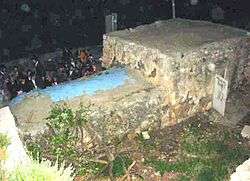 |
. |
| Joshua | Timnath-heres, attributed to Kifl Hares, Salfit Governorate, West Bank | 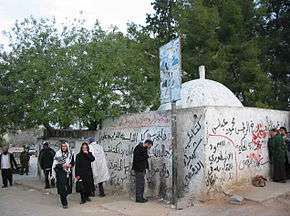 |
Thousands make the pilgrimage to his tomb on the annual commemoration of his death, 26th of Nisan on the Hebrew calendar. |
| Caleb | Timnath-heres, attributed to Kifl Hares, Salfit Governorate, West Bank | 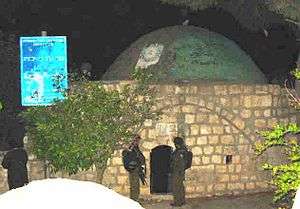 |
. |
| Othniel Ben Kenaz | Hebron, West Bank[11] | . | . |
| Shamgar | Tebnine, Lebanon[12] | . | . |
| Deborah, Barak and Yael | Tel Kaddesh, Israel[13] | 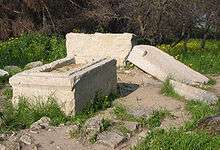 |
. |
| Samson | Beit Shemesh, Israel[14] | . | . |
| Elkanah | Kedita, Upper Galilee, Israel[15] | . | . |
| Hannah and Samuel | Tomb of Samuel, West Bank[16] (pictured). Other sources claim Samuel's tomb is located 30 km outside Saveh City, Iran. | 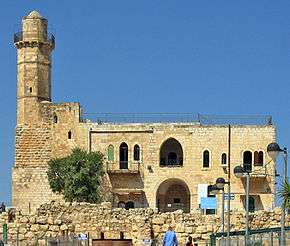 |
Both Jewish and Muslim prayers are held at the tomb. Many religious Jews visit the tomb on the 28th of Iyar, the anniversary of Samuel the Prophet's death. |
| Eli | Shiloh, Samaria | According to Jewish tradition the Yahrzeit of Eli the Cohen is on י' באייר — the tenth day of Iyar. | |
| Jesse and Ruth | Hebron, West Bank | .jpg) |
. |
| David | David's Tomb, Mount Zion, Jerusalem |  |
1 Kings 2:10 says that King David was buried in his own city; the City of David is on the southeastern hill of Jerusalem, Mount Zion is its western hill. The "tomb" is a Crusader-era cenotaph (symbolical, empty sarcophagus). The building dates to the 2nd century CE the earliest, and the tradition of David being buried here was created by Byzantine Christians well over a millennium after his supposed death.[17] |
| Absalom | Yad Avshalom, Mount of Olives, Jerusalem |  |
Archaeologists have dated the tomb to the first century CE. Its association with Absalom only dates from the 12th century.[18] Currently it is not considered by any religious group to be the tomb of Absalom, due to its age (1000 years too recent) and the Bible (2 Samuel 18:17, which says Absalom's body was covered over with stones in a pit in the forest of Ephraim). |
| Abner ben Ner | Hebron, West Bank[19] |  |
Rabbi Moses Basola visited the tomb in 1522.[20] Sefer Yihus ha-Tzaddiqim (Book of Genealogy of the Righteous), a collection of travel writings first published in 1561, mentions the tomb.[21] |
| Isaiah | Isaiah mausoleum, Esfahan, Iran[22] or Nahal Dishon, (Israel) | 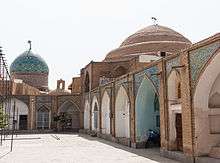 |
. |
| Hushai | Yirka, Israel | . | . |
| Iddo | Golan Heights,[23] | . | . |
| Jehoshaphat | Mount of Olives, Jerusalem [24] | . | . |
| Elisha | Elisha's Tomb. Disputed between: near Mt. Carmel, West Bank or Kfar Yassif near Acre, Israel | . | . |
| Huldah | Mount of Olives, Jerusalem Other sources place it adjacent to the Huldah Gates[25] | . | . |
| Zedekiah | Cave of Zedekiah, Old City of Jerusalem [26] | . | . |
| Ezekiel | Ezekiel's Tomb, Al Kifl, Iraq | 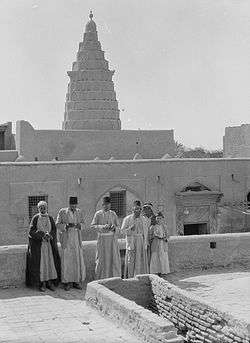 |
Up till the mid-20th century, up to 5,000 Jews used to come to the tomb during Passover.[27] Muslims believe this tomb to be that of an unspecified personality named Dhul-Kifl. (For an image of the tomb, see:[28]) This site was protected under the control of Saddam Hussein. |
| Baruch ben Neriah | Al Kifl, Iraq | . | His tomb is located about 1-mile (1.6 km) away from Ezekiel's Tomb |
| Hosea | Ancient Jewish cemetery of Safed, Israel[29] |  |
. |
| Amittai (father of Jonah) | Islam: Beit Ummar, near Hebron, West Bank | . | Mosque of Nabi Matta: The main mosque in Beit Ummar housing the tomb of Nabi Matta or Amittai, father of Jonah. Mujir ad-Din writes that Matta was "a holy man from the people of the house of the prophecy." Nearby Halhul houses the tomb of Jonah with the inscription reading "Yunus ibn Matta" or "Jonah son of Amittai", confirming that Matta is indeed the Arabic name for Amittai and the Beit Ummar tomb is dedicated to Amittai. In 1226, the Ayyubid sultan al-Mu'azzam built a mosque with a minaret under the supervision of Jerusalem governor Rashid ad-Din al-Mu'azzami. The Mamluks constructed some additions to the mosque and engraved several inscriptions on its surface.[7] |
| Jonah | Judaism: Mashhad, Israel. Islam: Halhul, near Beit Ummar, Hebron. There is however another famous site for the tomb of Jonah, Mosque of the Prophet Yunus, Mosul, Iraq. | . | . |
| Micah | Kabul, Israel[30] | . | . |
| Nahum | Al Qush, south of Dahuk, Iraq. There are however two other sites mentioned in historical accounts: Elkesi, near Ramah in the Galilee and Elcesei in the West Bank[31] | . | . |
| Habakkuk | Some locate it at Hokuk, others at Kadarim, Israel.[32][33] Others at Toyserkan, Iran.[34] (pictured) |  |
. |
| Zephaniah | En-Nabi Safi, Southern Lebanon[35] | . | . |
| Haggai and Malachi | Tomb of the Prophets, Mount of Olives, Jerusalem [36] | . | . |
| Zechariah | In Druzism: Abu Sinan, Israel, Islam Great Mosque of Aleppo in Syria. | . | . |
Figures mentioned in the Ketuvim (Writings)
| Biblical figure | Place name and location | Image | Notes |
|---|---|---|---|
| Job | In Druzism: Chouf District, Lebanon (pictured). Yaqut al-Hamawi recorded that it was located in Al-Shaykh Saad, while another tradition locates it at Salalah, Oman |  |
. |
| Jesse and Ruth | Hebron, West Bank | . | This location is in a cave. Today it is surrounded by IDF security and visitors usually light candles there and read passages from Psalms in their memories. |
| Mordecai and Esther | Tomb of Esther and Mordechai, Hamedan, Iran | 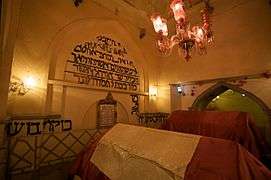 |
Persian Jews still make annual pilgrimage in honor of the Purim festival. |
| Daniel | Tomb of Daniel, Susa, Iran (pictured). There are however six other traditional sites including Kirkuk in Iraq and Samarkand in Uzbekistan | At the site in Kirkuk, the locals claim that Hananiah, Mishael, and Azaria are buried alongside Daniel. | |
| Ezra | Ezra's Tomb, Al-'Uzayr, near Basra, Iraq | Preserved by Jewish caretakers until the middle of the 20th century. From that point, a local Muslim Iraqi took the responsibility of preserving the location. The area surrounding the tomb is used today as a place of Muslim worship although Hebrew inscriptions are still present in the room. Located where Tigris and Euphrates meet. | |
| Lamech | Islam: Tomb of Lamech, Mihtarlam, Afghanistan | . | . |
| Zechariah ben Jehoiada | Tomb of Zechariah, Mount of Olives, Jerusalem | . |
Figures mentioned in the New Testament
- Tomb of Jesus
- John the Baptist in the Umayyad Mosque
- Tomb of the Virgin Mary
- Saint Peter's tomb
- Saint Mark's Coptic Orthodox Cathedral (Alexandria)
- Matthew the Apostle in the Salerno Cathedral
- James, son of Zebedee in the Santiago de Compostela Cathedral
- Luke the Evangelist in Thebes, Greece
- Basilica of St. John
- The so-called Tomb of Caiaphas was discovered by accident in 1990 and subsequently excavated by archaeologists.[37][38]
- Tomb of Herod the Great (discovered in 2007 by archaeologist Ehud Netzer after 35 years of searching)
- The Mausoleum of the Roman Emperor Augustus
See also
| Wikimedia Commons has media related to Tombs and graves of saintly people in Judaism. |
- Burial places of founders of world religions
- List of artifacts significant to the Bible
- List of mausolea
- Lives of the Prophets
- Ohel (grave)
References
- ↑ מקומות קדושים | קברי צדיקים - גליל תחתון - טבריה - שת בן אדם הראשון - SYT
- ↑ Corbin, Henry (2009). "The configuration of the Temple of the Ka´bah.". Temple and Contemplation. London: Roudledge. p. 227. ISBN 978-0-710-30129-1.
This is the hijr of Ishmael, or the house of Ishmael (Bayt Ismail), where he buried his mother Hagar and where he himself is buried.
- ↑ האבות, האמהות, הבנים והנביאים
- ↑ דן בן יעקב
- ↑ Pilgrimage in Palestine
- ↑ Goldman, Shalom (1995). "The Women of the Joseph Story". The Wiles of Women, The Wiles of Men. New York: SUNY Press. p. 115. ISBN 0-7914-2683-1.
- ↑ http://www.syt.co.il/showKever.asp?id=337 אלעזר בן אהרן הכהן
- ↑ Shuayb
- ↑ Druze Revered Sites in Palestine: Jethro's Tomb
- ↑ נחלת אשר
- ↑ Otniel ben Knaz
- ↑ Yeshiva.org.il - המשך ענין לבנון
- ↑ מקומות קדושים | קברי צדיקים - הגליל העליון ואצבע הגליל - גבול לבנון - ברק בן אבינעם - SYT
- ↑ שמשון הגיבור
- ↑ אלקנה
- ↑ מקומות קדושים | קברי צדיקים - ירושלים - צפון ירושלים - שמואל הנביא - SYT
- ↑ Jerome Murphy-O'Connor (2008). The Holy Land: An Oxford Archaeological Guide from Earliest Times to 1700. Oxford Archaeological Guides. Oxford: Oxford University Press. pp. 116–117. ISBN 978-0-19-923666-4. Retrieved 19 August 2016.
- ↑ Jerome Murphy-O'Connor (2008). The Holy Land: An Oxford Archaeological Guide from Earliest Times to 1700. Oxford Archaeological Guides. Oxford: Oxford University Press. p. 133. ISBN 978-0-19-923666-4. Retrieved 19 August 2016.
- ↑ Tomb of Avner ben Ner (Abner) in Hebron
- ↑ Avraham, David (1999-12-31). In Zion and Jerusalem: The Itinerary of Rabbi Moses Basola 1512-1523. Jerusalem: C G Gundation. ISBN 9789652229267.
- ↑ "URI (ORI) BEN SIMEON - JewishEncyclopedia.com". www.jewishencyclopedia.com. Retrieved 2016-01-04.
- ↑ Freedman, Warren. (1984) World Guide for the Jewish Traveler. NY: E.P. Dutton Inc
- ↑ עידו הנביא
- ↑ יהושפט
- ↑ חולדה הנביאה
- ↑ מקומות קדושים | קברי צדיקים - ירושלים - העיר העתיקה - מערת צדקיהו - SYT
- ↑ Passover pilgrimage to Ezekiel's tomb in Iraq
- ↑ http://www.johnberger.com/indexdead2.htm
- ↑ הושע הנביא
- ↑ מיכה הנביא
- ↑ Renovation- Al Qush Synagogue and the Tomb of Nahum.
- ↑ חבקוק הנביא
- ↑ Hukkok
- ↑ آلبوم عکسهای تویسرکان
- ↑ המשך ענין לבנון
- ↑ חגי הנביא
- ↑ Caiaphas’ Family Tomb Found, Chicago Tribune, August 14, 1992, http://articles.chicagotribune.com/1992-08-14/news/9203130273_1_caiaphas-ossuaries-burial-cave.
- ↑ The Tomb of Caiaphas’ Unearthed?, The New York Times, August 16, 1992, Author Michael Specter http://www.nytimes.com/1992/08/16/weekinreview/august-9-15-the-tomb-of-caiaphas-unearthed.html.
.jpg)
